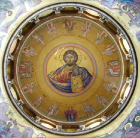Difference between revisions of "Monophysitism" - New World Encyclopedia
m (New page: {{Eastern Christianity}} '''Monophysitism''' (from the Greek '''monos''' meaning 'one, alone' and '''physis''' meaning 'nature'), or Monophysiticism, is the [[christology|Chri...) |
(applying credit tag) |
||
| Line 32: | Line 32: | ||
[[category:Christianity]] | [[category:Christianity]] | ||
[[category:history]] | [[category:history]] | ||
| + | |||
| + | {{credit|221069469}} | ||
Revision as of 02:53, 11 July 2008
| Part of the series on Eastern Christianity | |

| |
|
History | |
|
Traditions | |
|
Liturgy and Worship | |
|
Theology | |
Monophysitism (from the Greek monos meaning 'one, alone' and physis meaning 'nature'), or Monophysiticism, is the Christological position that Christ has only one nature (divine), as opposed to the Chalcedonian position which holds that Christ has two natures, one divine and one human. Monophysitism and its antithesis, Nestorianism, were both hotly disputed and divisive competing tenets in the maturing Christian traditions during the first half of the fifth century; a tumultuous period being the last decades of the Western Empire, and marked by the political shift in all things to a center of gravity now located in the Eastern Roman empire, and particularly in Syria, the Levant, Egypt, and Anatolia, where Monophysitism was popular among the people.
There are two major doctrines that can indisputably be called Monophysite (IPA: /məˈnɒfəsɪt/):
- Eutychianism holds that the human and divine natures of Christ were fused into one new single (mono) nature: his human nature was "dissolved like a drop of honey in the sea".
- Apollinarism or Apollinarianism holds that Christ had a human body and human "living principle" but that the Divine Logos had taken the place of the nous, or "thinking principle", analogous but not identical to what might be called a mind in the present day.
After Nestorianism, taught by Nestorius, Archbishop of Constantinople, was rejected at the First Council of Ephesus, Eutyches, an archimandrite at Constantinople, emerged with diametrally opposite views. Eutyches' energy and imprudence with which he asserted his opinions brought him the accusation of heresy in 448, leading to his excommunication. In 449, at the controversial Second Council of Ephesus Eutyches was reinstated and his chief opponents Eusebius, Domnus and Flavian, deposed. Monophysitism and Eutyches were again rejected at the Council of Chalcedon in 451.
Monophysitism is also rejected by the Oriental Orthodox Churches, but was widely accepted in Syria, the Levant, and Egypt leading to many tensions in the early days of the Byzantine Empire.
Later, Monothelitism was developed as an attempt to bridge the gap between the Monophysite and the Chalcedonian position, but it too was rejected by the members of the Chalcedonian synod, despite at times having the support of the Byzantine emperors and one of the Popes of Rome, Honorius I. Some are of the opinion that Monothelitism was at one time held by the Maronites, but the Maronite community, for the most part, dispute this, stating that they have never been out of communion with the Catholic Church.
Miaphysitism, the christology of the Oriental Orthodox churches, is sometimes considered a variant of Monophysitism, but these churches view their theology as distinct from Monophysitism and anathematize Eutyches.
See also
- Diophysitism
- Acephali
- Henotikon
- the Three-Chapter Controversy
- Christ the Logos
- West Syrian Rite
ReferencesISBN links support NWE through referral fees
- Agreed Statements between representative of the Oriental and Eastern Orthodox Churches
- Joint Declaration by the Oriental and the Catholic Church
- Catholic Encyclopedia article
Credits
New World Encyclopedia writers and editors rewrote and completed the Wikipedia article in accordance with New World Encyclopedia standards. This article abides by terms of the Creative Commons CC-by-sa 3.0 License (CC-by-sa), which may be used and disseminated with proper attribution. Credit is due under the terms of this license that can reference both the New World Encyclopedia contributors and the selfless volunteer contributors of the Wikimedia Foundation. To cite this article click here for a list of acceptable citing formats.The history of earlier contributions by wikipedians is accessible to researchers here:
The history of this article since it was imported to New World Encyclopedia:
Note: Some restrictions may apply to use of individual images which are separately licensed.